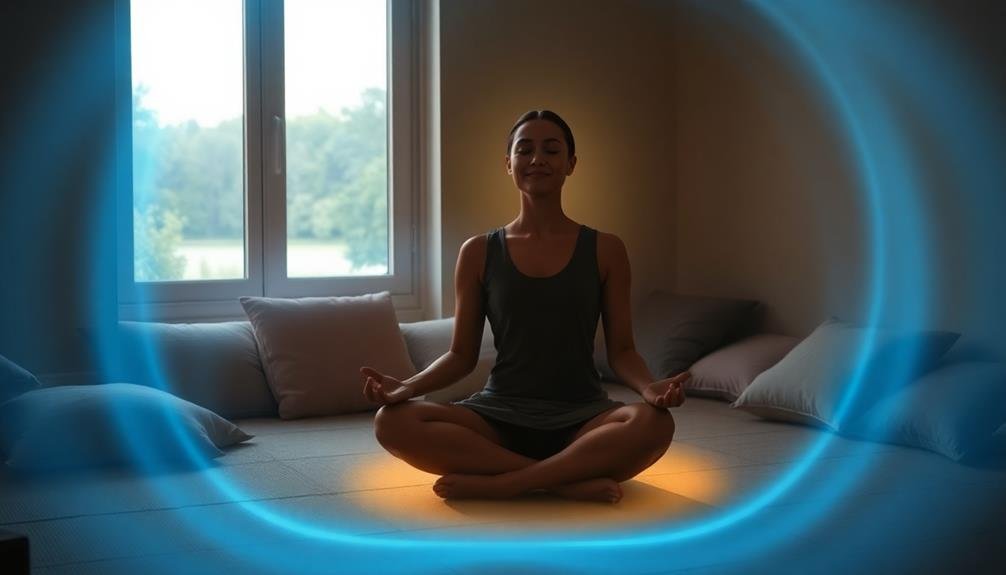Five powerful mantras can help ease your anxiety during meditation. "I Am Safe and Calm" reinforces inner strength and grounds you in the present. "This Too Shall Pass" offers perspective, reminding you that anxious feelings are temporary. "Breathe In Peace, Breathe Out Worry" combines focused breathing with positive affirmations. "I Accept What I Cannot Change" acknowledges limitations and promotes liberation. "My Mind Is Still" fosters tranquility amidst anxious thoughts. These mantras work by synchronizing words with breath, encouraging visualization, and promoting self-acceptance. By incorporating these mantras into your practice, you'll cultivate resilience and inner peace. Discover how each mantra can uniquely transform your meditation experience.
Key Takeaways
- "I am safe and calm" affirms presence, reinforces inner strength, and promotes relaxation when synchronized with breath.
- "This too shall pass" provides perspective, encouraging the view of anxiety as temporary and fostering resilience.
- "Breathe in peace, breathe out worry" combines focused breathing with positive affirmations to reduce anxiety.
- "I accept what I cannot change" promotes liberation by acknowledging limitations of control and fostering mental clarity.
- "My mind is still" cultivates tranquility amidst anxious thoughts through visualization and deliberate breathing techniques.
I Am Safe and Calm

During moments of anxiety, the mantra "I am safe and calm" can serve as a powerful anchor. This simple phrase reminds you of your inner strength and ability to overcome challenging emotions. As you repeat these words, you're actively reinforcing a sense of security and tranquility within yourself.
When using this mantra, focus on each word's meaning. "I am" affirms your present existence and grounds you in the moment. "Safe" reassures you that you're protected from harm, while "calm" suggests a state of peaceful composure. By combining these concepts, you're creating a mental sanctuary where anxiety has no place.
Practice this mantra during your meditation sessions, especially when you feel overwhelmed. Synchronize the words with your breath, inhaling on "I am" and exhaling on "safe and calm." This technique helps deepen your relaxation and enhances the mantra's effectiveness.
This Too Shall Pass

While "I am safe and calm" helps ground you in the present, "This too shall pass" offers a broader perspective on your anxiety. This mantra reminds you that your current state of anxiety isn't permanent. It encourages you to view your anxious feelings as temporary visitors rather than defining characteristics of your identity.
As you meditate, repeat "This too shall pass" silently or aloud. Focus on the impermanent nature of your anxiety. Visualize your anxious thoughts as clouds drifting across the sky of your mind, acknowledging their presence but allowing them to move on. This practice helps you detach from overwhelming emotions and gain a sense of control.
Remember that this mantra applies to both positive and negative experiences. It can help you appreciate joyful moments more fully while providing comfort during challenging times. By embracing the transient nature of all experiences, you'll develop resilience and a more balanced perspective on life's ups and downs.
Incorporate "This too shall pass" into your daily meditation routine to cultivate patience and acceptance. Over time, you'll find it easier to navigate anxiety with greater ease and confidence.
Breathe In Peace, Breathe Out Worry

This simple yet powerful mantra combines focused breathing with positive affirmations. As you inhale, visualize peace filling your body. On the exhale, imagine your worries leaving you. Repeat the phrase "Breathe in peace, breathe out worry" silently or aloud with each breath cycle.
This technique helps you focus on the present moment, reducing anxiety about the past or future. It also reinforces the idea that you have control over your thoughts and emotions. Practice this mantra during your meditation sessions or whenever you feel overwhelmed.
To enhance the effectiveness of this mantra, try incorporating different sensory elements:
| Sense | Inhale (Peace) | Exhale (Worry) |
|---|---|---|
| Visual | Soft, warm light | Dark clouds |
| Auditory | Gentle ocean waves | Fading white noise |
| Tactile | Warmth spreading | Tension releasing |
| Olfactory | Fresh air | Stale air |
I Accept What I Cannot Change

Acceptance often proves to be a powerful antidote to anxiety. When you embrace the mantra "I accept what I can't change," you're acknowledging that some circumstances are beyond your control. This realization can be incredibly liberating, allowing you to focus your energy on things you can influence.
During meditation, repeat this mantra to yourself, letting its meaning sink in. As you do, you'll likely notice:
- A sense of relief as you release the burden of trying to control everything
- Increased mental clarity and focus on actionable steps
- A growing ability to differentiate between changeable and unchangeable situations
By accepting what you can't change, you're not giving up. Instead, you're choosing to direct your efforts more effectively.
This mantra helps you cultivate resilience and adaptability, essential qualities for managing anxiety. It encourages you to let go of perfectionism and unrealistic expectations, which often fuel anxious thoughts.
My Mind Is Still

The mantra "My mind is still" offers a powerful counterpoint to the often turbulent nature of anxious thoughts. As you repeat this phrase during meditation, you're actively fostering a sense of calm and tranquility within your mind. This mantra serves as an anchor, helping you return to a state of mental stillness whenever anxious thoughts arise.
When practicing this mantra, focus on the sensations of stillness in your body and mind. Visualize your thoughts as leaves floating on a calm lake, acknowledging them without engaging. With each repetition, you're reinforcing the idea that your mind can be a peaceful sanctuary, even amidst external chaos.
| Benefits | Techniques |
|---|---|
| Reduces mental chatter | Slow, deliberate breathing |
| Enhances focus | Visualization of stillness |
| Promotes relaxation | Body scan for tension release |
| Builds mental resilience | Consistent daily practice |
Frequently Asked Questions
How Long Should I Repeat Each Mantra During Meditation?
You should repeat each mantra for as long as feels comfortable to you. There's no set time limit. Start with 5-10 minutes and adjust based on your experience. You'll know when it's time to move on.
Can I Create My Own Personalized Mantras for Anxiety Relief?
Yes, you can create your own personalized mantras for anxiety relief. Choose words or phrases that resonate with you and bring comfort. Keep them short, positive, and easy to remember. Repeat them during meditation or stressful moments.
Are There Specific Times of Day Best for Practicing These Mantras?
You can practice mantras anytime, but mornings and evenings are often ideal. Early mornings offer a fresh start, while evenings help you unwind. However, consistency is key, so choose a time that works best for your schedule.
How Do I Choose the Right Mantra for My Current Emotional State?
To choose the right mantra for your emotional state, reflect on your feelings. You'll want a mantra that resonates with your current needs. Trust your intuition and select words that bring comfort, strength, or peace to your mind.
Can These Mantras Be Effective for Managing Panic Attacks?
Yes, mantras can be effective for managing panic attacks. You'll find they help calm your mind and regulate breathing. Choose simple, soothing phrases that resonate with you. Practice regularly to make them more impactful during intense moments.
In Summary
You've now discovered five powerful mantras to help ease your anxiety during meditation. Remember, these phrases are tools to calm your mind and bring you back to the present moment. As you practice, you'll find which ones resonate most with you. Don't be discouraged if your mind wanders; it's normal. Keep returning to your chosen mantra. With time and consistency, you'll notice a reduction in anxiety and an increase in overall peace and well-being.





Leave a Reply